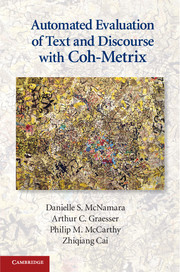Book contents
- Frontmatter
- Dedication
- Contents
- List of Figures
- List of Tables
- Acknowledgments
- Introduction
- Part I Coh-Metrix
- Part II A Beginner’s Guide to Writing Coh-Metrix Research
- 7 The Strategy
- 8 The Introduction
- 9 The Corpus
- 10 The Tool
- 11 The Results
- 12 The Discussion
- Concluding Remarks
- References
- Appendix A Coh-Metrix 3.0 Indices
- Appendix B Coh-Metrix Indices Norms
- Index
10 - The Tool
Published online by Cambridge University Press: 05 June 2014
- Frontmatter
- Dedication
- Contents
- List of Figures
- List of Tables
- Acknowledgments
- Introduction
- Part I Coh-Metrix
- Part II A Beginner’s Guide to Writing Coh-Metrix Research
- 7 The Strategy
- 8 The Introduction
- 9 The Corpus
- 10 The Tool
- 11 The Results
- 12 The Discussion
- Concluding Remarks
- References
- Appendix A Coh-Metrix 3.0 Indices
- Appendix B Coh-Metrix Indices Norms
- Index
Summary
As we mentioned at the beginning of Chapter 9, the Method section of most Coh-Metrix research papers comprises a section on the corpus and a section on the tool. In the last chapter, we discussed the corpus, and in this chapter we complete the traditional Method section by discussing the tool (which in this case is Coh-Metrix). Of course, by the time you have reached this point in the book, we assume that you already know a thing or two about Coh-Metrix. That is, you will likely know what it is for, which buttons to press to make it function, what the output looks like, and what some of the indices are. But knowing what Coh-Metrix is and knowing how to describe it for your readership are two quite different things. It is this description of the tool and its reason for inclusion in your project that forms the focus of this chapter.
The Four Major Moves of the Tool Section
In a research paper, the section describing the tool is relatively short because your study is not likely to be about Coh-Metrix; it is merely using Coh-Metrix. Therefore, all you need in order to describe the tool is to employ the following four moves: explain (1) what the tool is, (2) what it does, (3) why it can be trusted, and (4) why it is appropriate for the current study. To better understand these moves, let’s look at some examples that we’ve adapted from a study by Hall et al. (2007).
- Type
- Chapter
- Information
- Automated Evaluation of Text and Discourse with Coh-Metrix , pp. 163 - 175Publisher: Cambridge University PressPrint publication year: 2014



